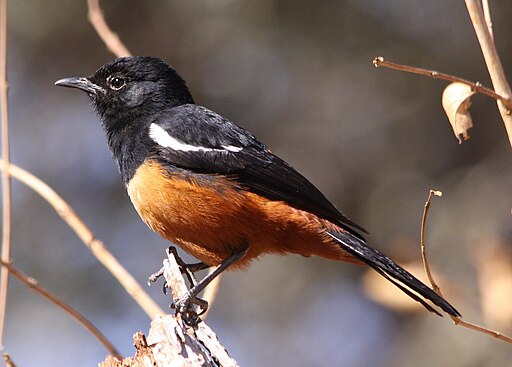Superregnum: Eukaryota
Cladus: Unikonta
Cladus: Opisthokonta
Cladus: Holozoa
Regnum: Animalia
Subregnum: Eumetazoa
Cladus: Bilateria
Cladus: Nephrozoa
Superphylum: Deuterostomia
Phylum: Chordata
Subphylum: Vertebrata
Infraphylum: Gnathostomata
Megaclassis: Osteichthyes
Cladus: Sarcopterygii
Cladus: Rhipidistia
Cladus: Tetrapodomorpha
Cladus: Eotetrapodiformes
Cladus: Elpistostegalia
Superclassis: Tetrapoda
Cladus: Reptiliomorpha
Cladus: Amniota
Classis: Reptilia
Cladus: Eureptilia
Cladus: Romeriida
Subclassis: Diapsida
Cladus: Sauria
Infraclassis: Archosauromorpha
Cladus: Crurotarsi
Divisio: Archosauria
Cladus: Avemetatarsalia
Cladus: Ornithodira
Subtaxon: Dinosauromorpha
Cladus: Dinosauriformes
Cladus: Dracohors
Cladus: Dinosauria
Ordo: Saurischia
Cladus: Eusaurischia
Cladus: Theropoda
Cladus: Neotheropoda
Cladus: Averostra
Cladus: Tetanurae
Cladus: Avetheropoda
Cladus: Coelurosauria
Cladus: Tyrannoraptora
Cladus: Maniraptoromorpha
Cladus: Maniraptoriformes
Cladus: Maniraptora
Cladus: Pennaraptora
Cladus: Paraves
Cladus: Eumaniraptora
Cladus: Avialae
Infraclassis: Aves
Cladus: Euavialae
Cladus: Avebrevicauda
Cladus: Pygostylia
Cladus: Ornithothoraces
Cladus: Ornithuromorpha
Cladus: Carinatae
Parvclassis: Neornithes
Cohors: Neognathae
Cladus: Neoaves
Cladus: Telluraves
Cladus: Australaves
Ordo: Passeriformes
Subordo: Passeri
Infraordo: Passerida
Superfamilia: Muscicapoidea
Familia: Muscicapidae
Genus: Thamnolaea
Species: Thamnolaea cinnamomeiventris
Subspecies: T. c. albiscapulata – T. c. autochthones – T. c. cinnamomeiventris – T. c. kordofanensis – T. c. odica – T. c. subrufipennis
Name
Thamnolaea cinnamomeiventris (Lafresnaye, 1836)
References
Magasin de Zoologie 6: cl.2, pl.55,56
Vernacular names
Afrikaans: Dassievoël
Deutsch: Rotbauchschmätzer
English: Mocking Cliff Chat
Esperanto: Cinamoventra formikulo
suomi: Isomuurahaistasku
français: Traquet à ventre roux
Nederlands: Roodbuikkliftapuit
português: Chasco-poliglota
svenska: Klippskvätta
The mocking cliff chat, mocking chat or cliff chat, (Thamnolaea cinnamomeiventris) is a species of chat in the family Muscicapidae which occurs in rocky habitats in much of eastern Sub-Saharan Africa.
Description
The mocking cliff chat is a large chat with distinctive colouration. The male has a glossy black with a chestnut belly, vent, and rump and white shoulder patches. The shoulder patches vary in size geographically. The female is dark grey with a chestnut lower breast, belly, and vent.[3] The mocking cliff chat has a length of 19–21 cm and weigh 41–51g.[4]
Voice
A loud fluty melodious warbling song which often contains many rapid fire phrases mimicking other species, with some harsher phrases interspersed.[3][5]
Distribution and movements
The mocking cliff chat occurs in a neat band from central Ethiopia in the north through east Africa into Zimbabwe, south-eastern Botswana, southern Mozambique and eastern South Africa as far as the far east of Western Cape province. Mostly resident but in the south of its range tends to move to lower altitudes in the winter months.[6]
Habitat
The mocking cliff chat inhabits rocky and boulder strewn areas, well-wooded rocky ravines, cliffs, gullies, boulder-strewn hillsides and watercourses in valley bottoms with scattered rocks.[6]
Habits
The mocking cliff chat is mainly insectivorous but also eats fruit and feeds on the nectar of aloes, such as the Krantz aloe Aloe arborescens. It chief foraging technique is to pounce on food on the ground from a perch bit it will also glean food from branches and foliage.[6] The habitually wag their tails, slowly raising over their backs and fanning it out.[5]
Both sexes build the nest, taking about a week to construct an open cup built over a foundation of twigs, leaves, roots and feathers and lined with the hair of mammals. They often use the nests of striped swallows frequently evicting the swallows while they are still using the nest. The nest is usually positioned below a rock overhang, bridge, culvert or in a cave and it may sometimes be placed in a hole in a wall or in a cavity in agricultural machinery. In southern Africa the eggs are laid from August–December, with a peak during September–November. The normal clutch size is 2-4 eggs, which the females incubates for about 14–16 days. Both parents feed the chicks which fledge at about three weeks old.[6]
Taxonomy
T. c. subrufipennis in Kenya
There are six currently recognised subspecies[2][4]
T. c. kordofanensis Wettstein, 1916 ― Nuba Mountains, in central Sudan
T. c. albiscapulata (Rüppell, 1837) ― northern Eritrea and northern, central and eastern Ethiopia
T. c. subrufipennis Reichenow, 1887 ― eastern South Sudan and south-western Ethiopia south through the Rift Valley and Tanzania to eastern Zambia and Malawi
T. c. odica Clancey, 1962 ― Eastern Zimbabwe
T. c. cinnamomeiventris (Lafresnaye, 1836) ― Eastern Botswana, eastern South Africa, western Swaziland and Lesotho
T. c. autochthones Clancey, 1952 ― Southern Mozambique south to north-eastern South Africa and eastern Swaziland
The white-crowned cliff chat (Thamnolaea coronata) of West Africa is sometimes included in this species.[4]
References
BirdLife International (2018). "Thamnolaea cinnamomeiventris". IUCN Red List of Threatened Species. 2018: e.T22710441A132088466. doi:10.2305/IUCN.UK.2018-2.RLTS.T22710441A132088466.en. Retrieved 13 November 2021.
"Thamnolaea cinnamomeiventris (Lafresnaye, 1836)". Integrated Taxonomic Information System (ITIS) (https://www.itis.gov). Retrieved 2016-11-20.
Ian Sinclair; Peter Ryan (2003). Birds of Africa south of the Sahara. Struik. pp. 472–473. ISBN 1-86872-857-9.
"Mocking Cliff-chat (Thamnolaea cinnamomeiventris)". HBW Alive. Lynx Edicions. Retrieved 2016-11-20.
Zimmerman, Dale A.; Turner, Donald A.; Pearson, David J. (1996). Birds of Kenya and Northern Tanzania. Helm. p. 548. ISBN 0-7136-3968-7.
"Thamnolaea cinnamomeiventris (Mocking cliff-chat, Mocking chat)". Biodiversity Explorer. Iziko Museums of South Africa. Retrieved 2016-11-20.
Retrieved from "http://en.wikipedia.org/"
All text is available under the terms of the GNU Free Documentation License


